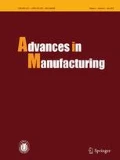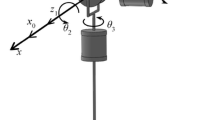Abstract
This study proposed a bio-inspired motion planning approach for the reaching movement of a robot manipulator based on a novel intrinsic tau jerk guidance strategy, which was established by some cognitive science researchers when they studied motion patterns through biology. In accordance with the rules of human reaching movement, the intrinsic tau jerk guidance strategy ensures continuity of the acceleration; further, it also ensures that its value is zero at the start and end of the movement. The approach has been implemented on a three-degrees-of-freedom 3R planar manipulator. The results show that, within a defined time, both the position gap and attitude gap can be reposefully closed, and the curves of joint velocity, acceleration, and driving torque are continuous and smooth. According to the dynamic analysis, the proposed approach tends to consume less energy. The bio-inspired method has the potential to be applied in particular scenarios in the future, such as a mobile robot with a manipulator exploring an unknown environment.











Similar content being viewed by others
References
Piazzi A, Visioli A (1997) An interval algorithm for minimum-jerk trajectory planning of robot manipulators. In: Proceedings of the 36th IEEE conference on decision and control. IEEE, San Diego, pp 1924–1927
Lippiello V, Ruggiero F (2012) 3D monocular robotic ball catching with an iterative trajectory estimation refinement. In: International conference on robotics and automation. IEEE, Saint Paul, pp 3950–3955
Lampariello R, Nguyen-Tuong D, Castellini C et al (2011) Trajectory planning for optimal robot catching in real-time. In: International conference on robotics and automation. IEEE, Shanghai, pp 3719–3726
Riley M, Atkeson CG (2002) Robot catching: towards engaging human-humanoid interaction. Auton Robot 12(1):119–128
Khan AT, Li S, Stanimirovic PS et al (2018) Model-free optimization using eagle perching optimizer. arXiv:1807.02754v1
Jiang X, Li S (2017) BAS: beetle antennae search algorithm for optimization problems. arXiv:1710.10724v1
Jiang X, Li S (2017) Beetle antennae search without parameter tuning (BAS-WPT) for multi-objective optimization. arXiv:1711.02395v1
Li S, He J, Li Y et al (2017) Distributed recurrent neural networks for cooperative control of manipulators: a game-theoretic perspective. IEEE Trans Neural Netw Learn Syst 28(2):415–426
Li S, Wang H, Rafique MU (2018) A novel recurrent neural network for manipulator control with improved noise tolerance. IEEE Trans Neural Netw Learn Syst 29(5):1908–1918
Regan D, Gray R (2001) Hitting what one wants to hit and missing what one wants to miss. Vis Res 41(25–26):3321–3329
Schiff W, Caviness JA, Gibson JJ (1962) Persistent fear responses in rhesus monkeys to the optical stimulus of “looming”. Science 136(15):982–983
Yonas A, Bechtold AG, Frankel D et al (1977) Development of sensitivity to information for impending collision. Atten Percep Psychophys 21(2):97–104
Lee DN (1976) Theory of visual control of braking based on information about time-to-collision. Perception 5(4):437–459
Lee DN, Reddish PE (1981) Plummeting gannets: a paradigm of ecological optics. Nature 293(5830):293–294
Lee DN (2009) General tau theory: evolution to date. Perception 38(6):837–850
Lee DN (1998) Guiding movement by coupling Taus. Ecol Psychol 10(3–4):221–250
Wagner H (1982) Flow-field variables trigger landing in flies. Nature 297(5862):147–148
Hatsopoulos N, Gabbiani F, Laurent G (1995) Elementary computation of object approach by a wide-field visual neuron. Science 270(5238):1000–1003
Sun H, Frost BJ (1998) Computation of different optical variables of looming objects in pigeon nucleus rotundus neurons. Nat Neurosci 1(4):296–303
Rock P, Harris MG (2006) Tau as a potential control variable for visually guided braking. J Exp Psychol Hum Percept Perform 32(2):251–267
Lee DN, Craig CM, Grealy MA (1999) Sensory and intrinsic coordination of movement. Proc Biol Sci 266(1432):2029–2035
Morrone MC, Tosetti M, Montanaro D et al (2000) A cortical area that responds specifically to optic flow, revealed by fMRI. Nat Neurosci 3(12):1322–1328
Field DT, Wann JP (2005) Perceiving time to collision activates the sensorimotor cortex. Curr Biol 15(5):453–458
Farid K (2014) Four-dimensional guidance and control of movement using time-to-contact: application to automated docking and landing of unmanned rotorcraft systems. Int J Robot Res 33(2):237–267
Mohamad TA, Victor MB, William H (2015) Bioinspired autonomous visual vertical control of a quadrotor unmanned aerial vehicle. J Guid Control Dyn 38(2):249–262
Zhang Z, Xie P, Ma O (2014) Bio-inspired trajectory generation for uav perching movement based on tau theory. Int J Adv Robot Syst 11:1–11
Yang Z, Fang Z, Li P (2016) Bio-inspired collision-free 4D trajectory generation for UAVs using tau strategy. J Bionic Eng 13(1):84–97
Zhang S, Zhang Z, Qian J (2014) Bio-inspired trajectory planning for robot catching movements based on tau theory. J Mech Eng 50(13):42–51
Zhang Z, Zhang S, Xie P et al (2014) Bioinspired 4D trajectory generation for a UAS rapid point-to-point movement. J Bionic Eng 11(1):72–81
Zhang S, Qian J, Zhang Z et al (2016) Age- and Parkinson’s disease-related evaluation of gait by general tau theory. Exp Brain Res 234(10):2829–2840
Alexander RMN (1997) A minimum energy cost hypothesis for human arm trajectories. Biol Cybern 76(2):97–105
Zhang Z, Xie P, Ma O (2013) Bio-inspired trajectory generation for UAS perching. In: IEEE/ASME international conference on advanced intelligent mechatronics. IEEE, Wollongong, pp 997–1002
Georgopoulos AP (1981) Spatial trajectories and reaction times of aimed movements: effects of practice, uncertainty, and change in target location. J Neurophysiol 46(4):725–743
Morasso P (1981) Spatial control of arm movements. Exp Brain Res 42(2):223–227
Soechting JF, Lacquaniti F (1981) Invariant characteristics of a pointing movement in man. J Neurosci 1(7):710–720
Abend W, Bizzi E, Morasso P (1982) Human arm trajectory formation. Brain 105(2):331–348
Atkeson CG, Hollerbach JM (1985) Kinematic features of unrestrained vertical arm movements. J Neurosci 5(9):2318–2330
Nagasaki H (1989) Asymmetric velocity and acceleration profiles of human arm movements. Exp Brain Res 74(2):319–326
Uno Y, Kawato M, Suzuki R (1989) Formation and control of optimal trajectory in human multi-joint arm movement. Biol Cybern 61(2):89–101
Flash T, Hogan N (1985) The coordination of arm movements: an experimentally confirmed mathematical model. J Neurosci 5(7):1688–1703
Todorov E (2004) Optimality principles in sensorimotor control. Nat Neurosci 7(9):907–915
Fligge N (2012) Minimum jerk for human catching movements in 3D. In: IEEE RAS/EMBS international conference on biomedical robotics and biomechatronics. IEEE, Rome, pp 581–586
Corke PI (2017) Robotics, vision and control: fundamental algorithms in MATLAB. Springer, Berlin
Acknowledgements
This work was jointly supported by the National Natural Science Foundation of China (Grant No. 51005143) and Shanghai Science and Technology Commission (Grant No. 18JC1410402).
Author information
Authors and Affiliations
Corresponding author
Rights and permissions
About this article
Cite this article
Zhang, Z., Yang, X. Bio-inspired motion planning for reaching movement of a manipulator based on intrinsic tau jerk guidance. Adv. Manuf. 7, 315–325 (2019). https://doi.org/10.1007/s40436-019-00268-z
Received:
Revised:
Accepted:
Published:
Issue Date:
DOI: https://doi.org/10.1007/s40436-019-00268-z




